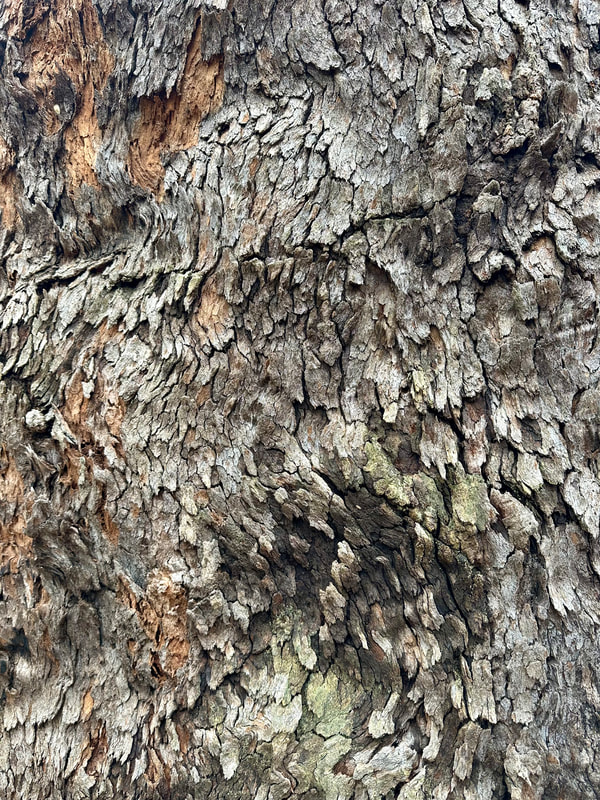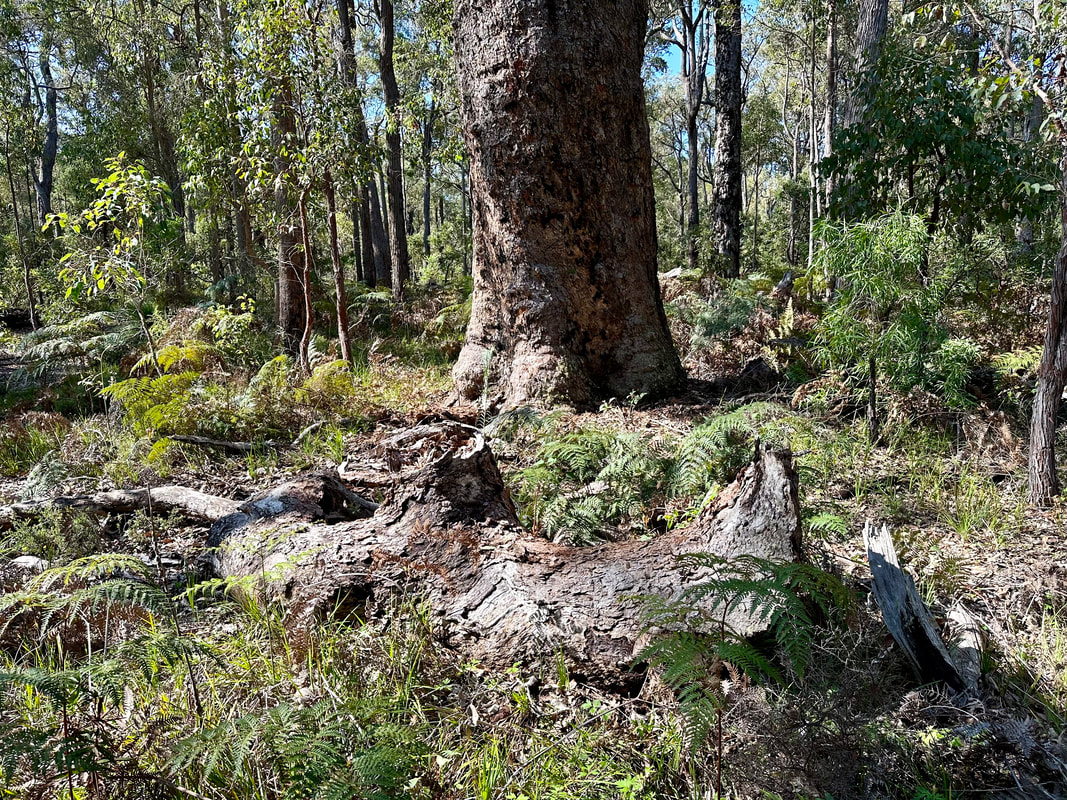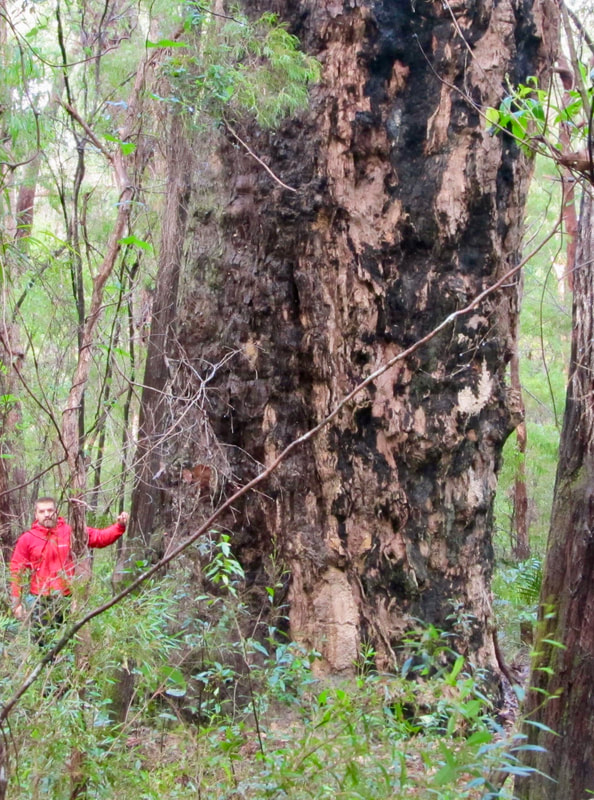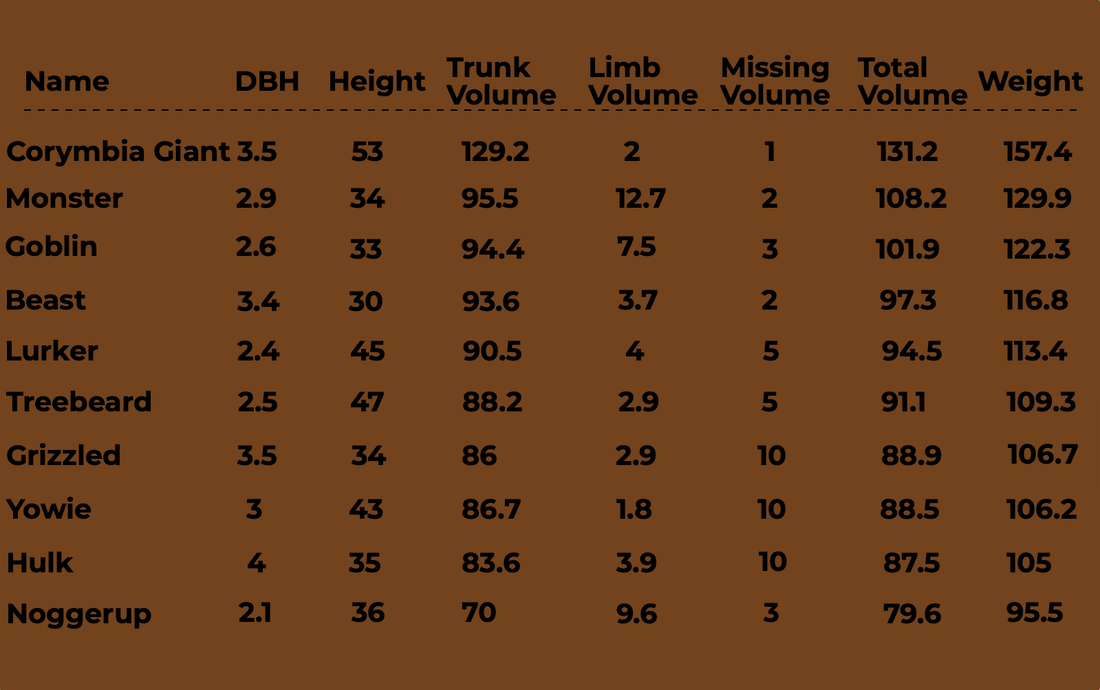Marri (Corymbia calophylla) is an impressive forest tree with a solid trunk and dense canopy famed for its large gum nuts. It was previously classified as a Eucalyptus species but in 1995 was reclassified as Corymbia. However, some organisations don't recognise this and still ally it with the eucalypts. Marri is found throughout the Southwest region of WA co dominating within the Jarrah Forest. Marri also inhabit the Tuart Woodlands, karri forest and tingle forests over an area originally around 68500 km². It is still a common species, but large mature specimens are rare. Marri wasn't historically logged as intensively for timber as other WA species, but instead cleared to open up the land for agriculture or used for woodchips. Marri proved remarkably resilient to the usual logging methods, gelignite placed around the base and roots and ignited was found to be effective at felling them! Some forest remnant trees have been left to provide shade for cattle, but many of these lone giants are succumbing to the elements faster than in a natural forest setting.
Marri wood is durable but tends to have structural faults which render it unsuitable for general construction. It is, however, becoming popular as a furniture timber with light, honey-coloured wood that gives it unique and attractive vein patterning. Marri produces high amounts of kino, a type of gum that bleeds out as a protective response to mechanical damage. The kino has been used for medicinal purposes by the local Noongar Aboriginal people for thousands of years. Also, kino contains tannin which was used to dye and preserve animal skins and was an important export from WA in the early 1900s.
Marri wood is durable but tends to have structural faults which render it unsuitable for general construction. It is, however, becoming popular as a furniture timber with light, honey-coloured wood that gives it unique and attractive vein patterning. Marri produces high amounts of kino, a type of gum that bleeds out as a protective response to mechanical damage. The kino has been used for medicinal purposes by the local Noongar Aboriginal people for thousands of years. Also, kino contains tannin which was used to dye and preserve animal skins and was an important export from WA in the early 1900s.
The above image shows typical marri bark. The younger inner bark is brown to orange with older, outer bark a brown to grey colour. The bark is scaly, wavy, irregular in pattern, and also regular grid like in pattern all on the same tree! Also marri tend to have burls and kino present in more mature trees, making identification of giant trees easier than others of the Southwest. Marri has been aged to 350 years old and grows over a wide range of conditions, but can develop into giant trees in wetter conditions ideally with a rainfall between 1000-1500 mm annually. While marri can grow in poor sandy soil, it prefers laterite and alluvium soil. Marri grow in association with jarrah throughout its range, but tend to develop into giants in karri loam soil in the Warren ecoregion. Indeed the biggest marri are all found in karri country with the over half the twenty biggest marri found there. Marri, like all WA tree species except karri rarely exceed 50 m in height. The fruit of marri called gum nuts or locally honky nuts are large and well protected. However, several birds have evolved to open the robust fruit to get to the seeds, such as the red-capped parrot (Purpureicephalus spurius) and the endangered Baudin's black cockatoo (Calyptorhynchus baudinii). Old marri trees play critical ecological roles providing shade and nesting hollows for a wide range of animals, particularly WA's three species of black cockatoos. Their scaly bark also provides habitat for a variety of insect life which in turn attracts predators.
Marri is often overlooked compared to its more famous WA tree cousins. Over the years I have grown in fondness towards them. In 2023 I went back to all the largest trees on my lists to refresh the images on this site with better quality ones on my upgraded smartphone. I was initially devastated to find the Ogre had fallen, along with the Creeper and Troll! I hastily measured the 3 biggest I knew of nearby to 'replace' these beasts with all 3 between 70-75 m³ in volume. Hopefully there's a few giant marri over 80 m³ and I'll be lucky enough to find them!
Marri is often overlooked compared to its more famous WA tree cousins. Over the years I have grown in fondness towards them. In 2023 I went back to all the largest trees on my lists to refresh the images on this site with better quality ones on my upgraded smartphone. I was initially devastated to find the Ogre had fallen, along with the Creeper and Troll! I hastily measured the 3 biggest I knew of nearby to 'replace' these beasts with all 3 between 70-75 m³ in volume. Hopefully there's a few giant marri over 80 m³ and I'll be lucky enough to find them!
I particularly like old weathered specimens due to their craggy, warty appearance and gnarl factor. These beasts are often partially burnt at the base with kino bleeding out from many unknown sources with multiple trunk burls. Often their bases are rarely buttressed, and their trunk barely tapers, even when limbs emerge, it's quite remarkable. They have heavy, arm like limbs reaching up and over then nearing the ground, like huge monster fingers from a fairy story. I have named some to match these characteristics!
Historical Accounts
I have not been able to find historic images of particularly large marri trees. I have come across a few large fallen marri over the years. There was a 3 m DBH marri 5 km south of Bunbury I planned to measure, until it fell and the farmer burnt it! It was about 80 m³ in total volume in my rough estimation. I received some images of another fallen giant marri of similar proportions in 2021 from a farmers wife on their property. You can clearly see it on Google Maps! The biggest now downed or historical marri are in fact the ones I had found and were on my website, but are now sadly fallen around 2015-2020. These include the Ogre, the second largest marri, followed by Troll, and Creeper.
I have not been able to find historic images of particularly large marri trees. I have come across a few large fallen marri over the years. There was a 3 m DBH marri 5 km south of Bunbury I planned to measure, until it fell and the farmer burnt it! It was about 80 m³ in total volume in my rough estimation. I received some images of another fallen giant marri of similar proportions in 2021 from a farmers wife on their property. You can clearly see it on Google Maps! The biggest now downed or historical marri are in fact the ones I had found and were on my website, but are now sadly fallen around 2015-2020. These include the Ogre, the second largest marri, followed by Troll, and Creeper.
This image of the Ogre is from 2013. It was an enormous marri I spied 11 km south of Pemberton off a main road in 2012. I later found its coordinates on the WA tree register listed as 2.1 m in DBH in 1988. It was hard to believe it put on over a metre of diameter in 20 years, unless it was a typo? I recorded a DBH of 3.3 m and 4.1 m at ZG in 2012. It was the first really large marri I saw and I realised they were probably the third biggest tree of the Southwest after karri and red tingle. What a shame it fell. Keelan, a fellow tree hunter could not find it from my coordinates in 2021, we suspected it had fallen and I found its huge trunk lying on the forest floor in 2023.
This image of Troll is from 2013. Found within the Hawke Grove it was 2.6 m in DBH and 83.2 m³ in total volume. It only had a 10 m tall trunk but several massive limbs that resembled the troll toys spiky hair! I unfortunately found it lying on the forest floor when I ventured in to update the website with better images in 2023.
This image of the Creeper is from 2012. I found this marri off Larkin Road, 2 km from the Hawke Grove. It was 2.6 m in DBH and 80.2 m³ in total volume. It had a very slow tapering 18 m tall trunk, and hardly any limbs.






